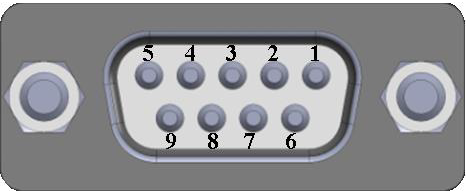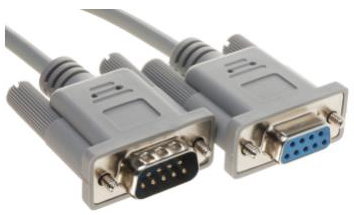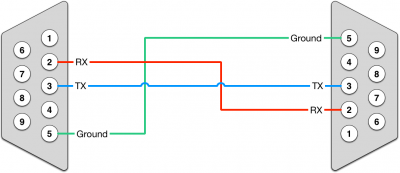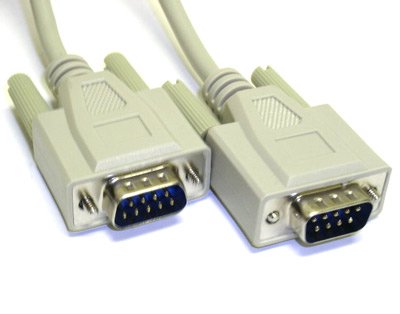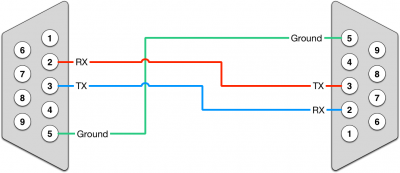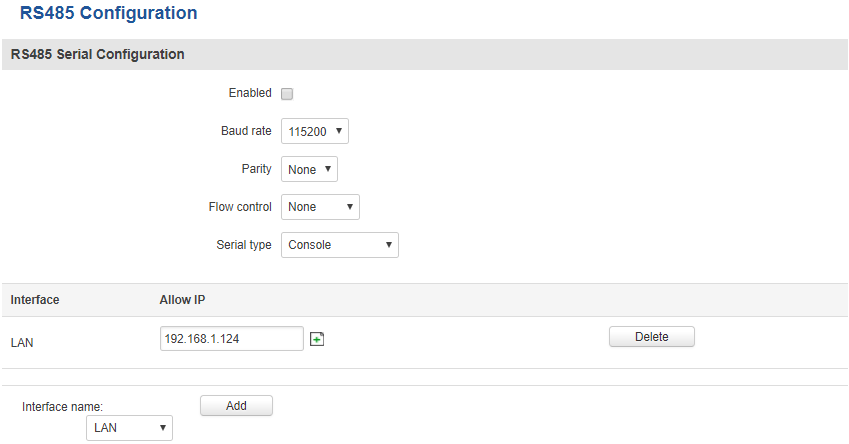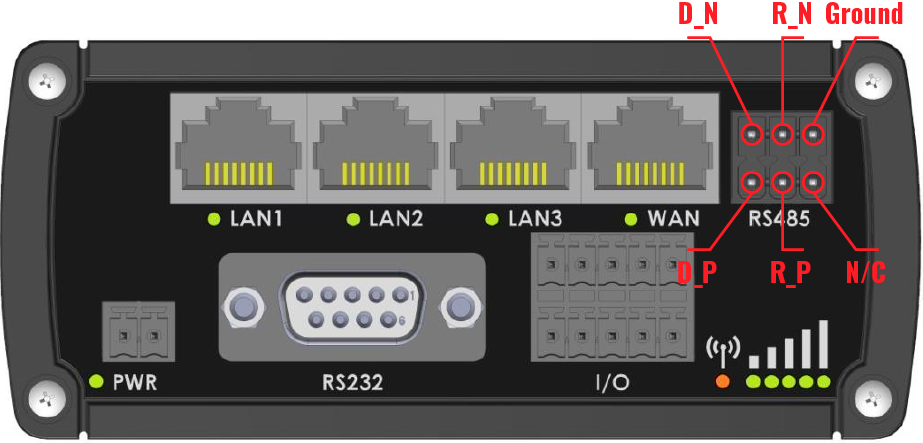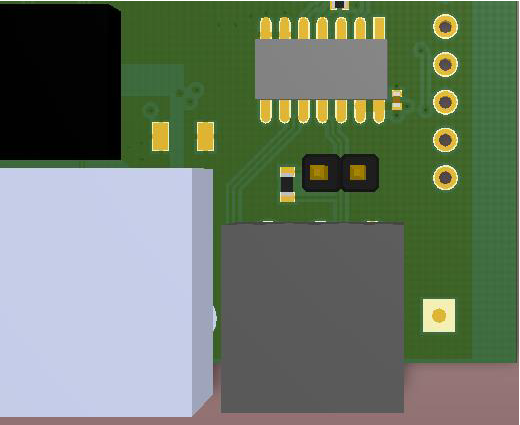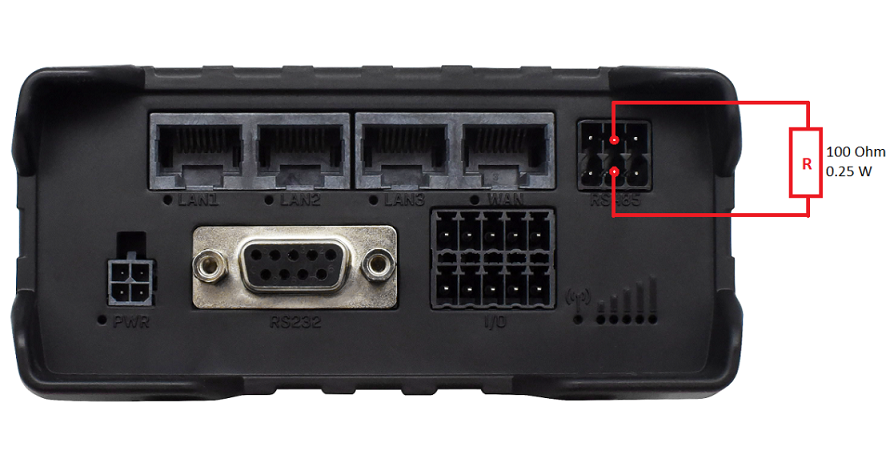RUT955 RS232: Difference between revisions
No edit summary |
|||
| Line 283: | Line 283: | ||
[[Image:Services rs485 jumper.PNG|border|class=tlt-border ]] | [[Image:Services rs485 jumper.PNG|border|class=tlt-border ]] | ||
But on facelifted RUT955 terminator links are missing. Since the RUT955 facelift housing is not disassembled, the termination resistor must be connected to the outside of the device by connecting a through-hole 100 ohm resistor to the terminal contacts. | |||
The connection of the external resistor is shown in the figure: | |||
[[Image:Networking rut manual services rs485 termination v1.png|border|class=tlt-border ]] | |||
===Number of devices in an RS-485 Network=== | ===Number of devices in an RS-485 Network=== | ||
Revision as of 14:44, 24 August 2020
Main Page > EOL Products > RUT955 > RUT955 Manual > RUT955 WebUI > RUT955 Services section > RUT955 RS232Summary
RS232 and RS485 functions are designed to utilize available serial interfaces of the router. Serial interfaces provide a possibility for legacy devices to gain access to IP networks. This chapter is an overview of the RS232/RS485 functions in RUT routers.
The information in this page is updated in accordance with the RUT9XX_R_00.06.06 firmware version.
RS232
| field name | value | description |
|---|---|---|
| Enabled | yes | no; Default: no | When checked, enables the RS232 service |
| Baud rate | 300 | 1200 | 2400 | 4800 | 9600 | 19200 | 38400 | 57600 | 115200; Default: 115200 | Sets the data rate for serial data transmission (in bits per second) |
| Data bits | 5 | 6 | 7 | 8; Default: 8 | The number of data bits for each character |
| Parity | None | Odd | Even; Default: None | In serial transmission, parity is a method of detecting errors. An extra data bit is sent with each data character, arranged so that the number of 1 bits in each character, including the parity bit, is always odd or always even. If a byte is received with the wrong number of 1s, then it must have been corrupted. However, an even number of errors can pass the parity check. None (N) - no parity method is used Odd (O) - the parity bit is set so that the number of "logical ones (1s)" has to be odd Even (E) - the parity bit is set so that the number of "logical ones (1s)" has to be even |
| Stop bits | 1 | 2; Default: 1 | Stop bits sent at the end of every character allow the receiving signal hardware to detect the end of a character and to resynchronise with the character stream. Electronic devices usually use one stop bit. Two stop bits are required if slow electromechanical devices are used |
| Flow control | None | RTS/CTS | Xon/Xoff; Default: None | In many circumstances a transmitter might be able to send data faster than the receiver is able to process it. To cope with this, serial lines often incorporate a "handshaking" method, usually distinguished between hardware and software handshaking. RTS/CTS - hardware handshaking. RTS and CTS are turned OFF and ON from alternate ends to control data flow, for instance when a buffer is almost full Xon/Xoff - software handshaking. The Xon and Xoff characters are sent by the receiver to the sender to control when the sender will send data, i.e., these characters go in the opposite direction to the data being sent. The circuit starts in the "sending allowed" state. When the receiver's buffers approach capacity, the receiver sends the Xoff character to tell the sender to stop sending data. Later, after the receiver has emptied its buffers, it sends an Xon character to tell the sender to resume transmission |
| Serial type | Console | Over IP | Modem | Modbus gateway | NTRIP client; Default: Console | Specifies the serial connection type. |
| Echo | yes | no; Default: no | Toggles RS232 echo ON or OFF. RS232 echo is a loopback test usually used to check whether the RS232 cable is working properly |
RS232 Connector Pinout
RS232 connector type on this device is DCE female. DCE stands for Data Communication Equipment.
| PIN | NAME* | DESCRIPTION* | DIRECTION ON THIS DEVICE |
|---|---|---|---|
| 1 | DCD | Data Carrier Detect | Output |
| 2 | RXD | Receive Data | Output |
| 3 | TXD | Transmit Data | Input |
| 4 | DTR | Data Terminal Ready | Input |
| 5 | GND | Signal Ground | - |
| 6 | DSR | Data Set Ready | Output |
| 7 | RTS | Ready To Send | Input |
| 8 | CTS | Clear To Send | Output |
| 9 | RI | Ring Indicator | Output (connected to +5V permanently via a 4.7k resistor) |
* The names and descriptions that indicate signal direction (such as TXD, RXD, RTS, CTS, DTR, and DSR) are named from the point of view of the DTE device.
Cables
There are two types of RS232 serial devices: DTE and DCE. DTE typically refers to the serial port on a PC or terminal, while DCE refers to communication devices. Connectors mounted on DTE are likely to be male, and those mounted on DCE are likely to be female.
This device is DCE and has a female connector.
To connect a standard DTE device, use a straight-through Female/Male RS232 cable:
See straight cable pinout below:
To connect another DCE device to RUT955, a Null-modem (crossed) Male/Male cable should be used:
See straight crossed cable pinout below:
Maximum cable length is 15 meters or the cable length equal to a capacitance of 2500 pF (for a 19200 baud rate). Using lower capacitance cables can increase the distance. Reducing communication speed can also increase maximum cable length.
RS485
RS-485 is a different serial data transmission standard for use in long ranges or noisy environments.
| field name | value | description |
|---|---|---|
| Enabled | yes | no; Default: no | Toggles the RS485 serial port function ON or OFF |
| Baud rate | 300 | 1200 | 2400 | 4800 | 9600 | 19200 | 38400 | 57600 | 115200; Default: 115200 | The communication speed of the serial interface |
| Parity | None | Odd | Even; Default: None | The parity bit setting used for error detection during data transfer |
| Flow control | None | RTS- CTS | Xon-Xoff; Default: None | Specifies how many stop bits will be used to detect the end of character |
| Serial type | Console | Over IP | Modem | Modbus Gateway | NTRIP Client; Default: Console | Specifies the function of the serial interface |
| Interface | LAN | WAN | VPN | L2TP | PPTP | GRE | HOTSPOT | SSTP; Default: LAN | Interface used for connection |
| Allow IP | ip; Default: " " | Allows IP to connect to server |
Maximum data rate vs. transmission line length
RS-485 standart can be used for network lengths up to 1200 meters, but the maximum usable data rate decreases as the transmission length increases. A device operating at the maximum data transfer rate (10Mbps) is limited to a transmission length of about 12 meters, while the 100kbps data rate can achieve a distance up to 1200 meters. A rough relation between maximum transmission length and data rate can be calculated using this approximation:
Where Lmax is the maximum transmission length in meters and DR is maximum data rate in bits per second.
Twisted pair is the prefered cable type for RS-485 networks. Twisted pair cables pick up noise and other electromagnetically induced voltages as common mode signals, which are rejected by the differential receivers.
Cable Type
Recommended cable parameters:
| PARAMETER | VALUE |
|---|---|
| Cable Type | 22-24 AWG, 2 – pair (used for full-duplex networks ) or 1-pair (used for half duplex networks). One addtitional wire for ground connection is needed |
| Characteristic cable Impedance | 120 Ω @ 1MHz |
| Capacitance (conductor to conductor) | 36 pF/m |
| Propagation Velocity | 78% (1.3 ns/ft) |
RS485 connector pin-out
| NAME | DESCRIPTION | TYPE |
|---|---|---|
| D_P | Driver positive signal | Differential Output |
| D_N | Driver negative signal | Differential Output |
| R_P | Receiver positive signal | Differential Input |
| R_N | Receiver negative signal | Differential Input |
| Ground | Device ground | Differential Output |
2-Wire and 4-Wire Networks
Below is an example of a 4-wire network electrical connection. There are 3 devices shown in the example. One of the devices is the “master” and other two are “slaves”. Termination resistors are placed at each cable end. Four-wire networks consists of one „master“ with its transmitter connected to each of the “slaves‘” receivers on one twisted pair. The “slave” transmitters are all connected to the “master” receiver on a second twisted pair.
Example 2-wire network electrical connection: to enable a 2-wire RS-485 configuration on a Teltonika router, you need to connect D_P to R_P and D_N to R_N on the device’s RS-485 socket. Termination resistors are placed at each cable end.
Termination
When to use (place jumper)
Termination resistor, equal in resistance to cable characteristic impedance, must be connected at each end of the cable to reduce reflection and ringing of the signals when the cable lengths get relatively long. Rise time of the RUT955 RS-485 driver is about 5 ns, so the maximum unterminated cable length is about 12 cm. As transmission line cables will always be longer than 12 cm, termination is mandatory all the time if RUT955 is located at the end of the cable.
When not to use (remove jumper)
If your RS-485 consists of more than two devices and the RUT955 router is located not on the end of the line but, for example, in the middle, RUT955 termination resistor needs to be disabled. In this case, place termination at other devices which are situated at the ends of the line.
How to enable termination
120 Ω termination resistor is included on the RUT955 PCB and can be enabled by shorting contacts (shown in the picture below), placing 2.54mm pitch jumper:
But on facelifted RUT955 terminator links are missing. Since the RUT955 facelift housing is not disassembled, the termination resistor must be connected to the outside of the device by connecting a through-hole 100 ohm resistor to the terminal contacts. The connection of the external resistor is shown in the figure:
Number of devices in an RS-485 Network
One RUT955 RS-485 driver is capable of driving a maximum of 32 receivers, provided that the receiver input impedance is 12 kΩ. If receiver impedances are higher, the maximum number of receivers in the network increases. Any combination of receiver types can be connected together, provided their parallel impedance does not exceed RLoad > 375 Ω.
Modes of different serial types in RS232 and RS485
Console
In this mode the serial interface set up as a Linux console of the device. It can be used for debugging purposes, to get the status of the device or to control it.
Over IP
In Over IP Serial type the router provides a connection to a TCP/IP network for the devices connected via serial interfaces.
Mode: Server
| field name | value | description |
|---|---|---|
| Protocol | TCP; Default: TCP | Specifies the protocol used in the communication process |
| Mode | Server | Client | Bidirect; Default: Server | Specifies the device's role in the connection: Server - the device waits for incoming connections Client - the device initiates the connection Bidirect - acts as client by default but waits for incoming connections at the same time |
| No leading zeros | yes | no; Default: no | Specifies that the first hex zeros should be skipped |
| TCP port | integer [0..65535]; Default: " " | The port number used to connect to the server |
| Timeout (s) | integer; Default: " " | Disconnects clients after the amount of inactivity time (in seconds) specified in this field |
Mode: Client
| field name | value | description |
|---|---|---|
| Protocol | TCP; Default: TCP | The protocol used for data transmission |
| Mode | Server | Client | Bidirect; Default: Server | Server - waits for incoming connection
Client - initiates the connection Bidirect – acts as a client by default, but at the same time waits for incoming connections |
| No leading zeros | yes | no; Default: no | Skips first hex zeros |
| Server address | host | ip; Default: no | Server address to which the client will connect to |
| TCP port | integer [0..65535]; Default: " " | The port number used to listen for incoming connections |
| Reconnect intervals (s) | integer; Default: " " | Indicates the time period between reconnection attempts |
Mode: Bidirect
File:Services rs232 rs485 overip bidirect.PNG
| field name | value | description |
|---|---|---|
| Mode | Server | Client | Bidirect; Default: Server | Server - waits for incoming connection
Client - initiates the connection Bidirect – acts as a client by default, but at the same time waits for incoming connections |
| No leading zeros | yes | no; Default: no | Skips first hex zeros |
| Server address | host | ip; Default: no | Server address to which the client will connect to |
| TCP port | integer [0..65535]; Default: " " | The port number used to listen for incoming connections |
| Reconnect intervals (s) | integer; Default: " " | Indicates the time period between reconnection attempts |
| TCP port | integer [0..65535]; Default: " " | The port number used to listen for incoming connections |
| Timeout (s) | integer; Default: " " | Disconnects client after the specified timeout of inactivity |
| Output | OC Output | Relay Output; Default: OC Output | Output to indicate that application switched from client (default) to server state |
| Output state | integer [0..1]; Default: 0 | Output state value after the application reverts to server mode |
Modem
With Modem Serial type, the router imitates a dial-up modem. Connections to TCP/IP networks can be established using AT commands. The connection can be initiated by the device connected via serial interface with an ATD command: ATD <host>:<port>. If Direct connect settings are specified, the connection to the server is always active. Data mode can be entered by issuing the ATD command. Incoming connections are indicated by sending a RING to the serial interface.
| field name | value | description |
|---|---|---|
| Direct connect | host:port | ip:port; Default: " " | Maintains a constant connection to specified host. Leave empty to use an ATD command to initiate the connection |
| TCP port | integer [0..65535]; Default: " " | The port number used to listen for incoming connections. Leave it empty to disable incoming connections |
| Initiation string | string; Default: " " | A command string that will be sent to the modem to initiate it in some special way |
| No extra CR LF in response | yes | no; Default: yes | Removes extra CR LF before and LF after response code |
This is the AT command set* used in Modem mode of the serial interfaces:
| COMMAND | DESCRIPTION | USAGE |
|---|---|---|
| A | Answers incoming call | To answer incoming connection: ATA |
| D | Dial a number | To initiate data connection: ATD <host>:<port> To enter data mode with Direct connect settings: ATD |
| E | Local echo | Turn local echo on: ATE1 Turn local echo off: ATE0 |
| H | Hang up current call | To end data connection: ATH |
| O | Return to data mode | To return to data mode from command mode: ATO |
| Z | Reset to default configuration | To reset the modem to default configuration: ATZ |
* Only these commands are supported in Modem mode.
Modbus gateway
The Modbus gateway Serial type allows redirecting TCP data coming to a specified port to RTU specified by the Slave ID. The Slave ID can be specified by the user or be obtained directly from the Modbus header.
| field name | value | description |
|---|---|---|
| Listening IP | ip; Default: 0.0.0.0 | IP address on which the Modbus gateway will wait for incoming connections |
| Port | integer [0..65535]; Default: " " | The port number used to listen for incoming connections |
| Slave ID configuration type | User defined | Obtained from TCP; Default: User defined | Specifies whether slave IDs are user defined or automatically obtained from TCP |
| Slave ID | Permitted slave IDs | integer | range of integers; Default: 1 | Specifies the slave ID of range of permitted slave IDs. The way this field is named and its function depends on the value of the Slave ID configuration field. A range of IDs can be specified by placing a hyphen (-) between two integer numbers. For example, if you permitt slave IDs in the range of 10 to 20, you would specify it as: 10-20 You can also specify multiple values that are not connected in a range using commas (,). For example, to specify 6, 50 and 100 as permitted slave IDs, you would have to use: 6,50,100 |
NTRIP client
Networked Transport of RTCM via Internet Protocol (Ntrip) is a protocol for streaming differential GPS (DGPS) data over the Internet in accordance with specification published by RTCM.
File:Services rs232 rs485 ntrip.PNG
| field name | value | description |
|---|---|---|
| IP address | ip; Default: 0.0.0.0 | IP address of the NTRIP server |
| Port | integer [0..65535]; Default: " " | TCP/UDP port used for NTRIP communication |
| Mount point | string; Default: " " | NTRIP mount point |
| Data format | NTRIP V2.0 TCP/IP | NTRIP V2.0 RSTP/RTP | NTRIP V1.0 | Automatic detection | NTRIP V2.0 UDP; Default: NTRIP V1.0 | Specifies the used version of NTRIP |
| Username | string; Default: " " | User name for NTRIP authentication |
| Password | string; Default: " " | Password for NTRIP authentication |
| Default NMEA string | string; Default: " " | Optional NMEA string that will be used as the default value when initiating the connection to the NTRIP server (this value is only sent to the server if there is no NMEA from router's GPS device) |
| Use device GPS | yes | no; Default: no | Allows to obtain default NMEA string from the router's GPS device. Only works if GPS service is enabled and location fix is obtained at the time of NTRIP service start |

